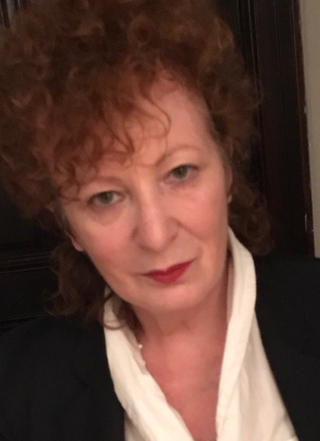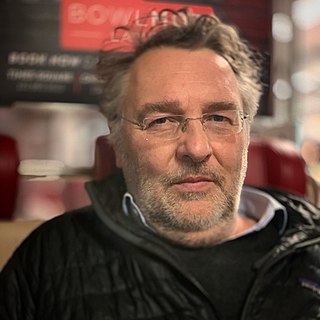Related Research Articles

Martin Parr is a British documentary photographer, photojournalist and photobook collector. He is known for his photographic projects that take an intimate, satirical and anthropological look at aspects of modern life, in particular documenting the social classes of England, and more broadly the wealth of the Western world.

Nancy Goldin is an American photographer and activist. Her work often explores LGBT subcultures, moments of intimacy, the HIV/AIDS crisis, and the opioid epidemic. Her most notable work is The Ballad of Sexual Dependency (1986). The monograph documents the post-Stonewall, gay subculture and includes Goldin's family and friends. She is a founding member of the advocacy group P.A.I.N.. She lives and works in New York City.

Joel Meyerowitz is an American street, portrait and landscape photographer. He began photographing in color in 1962 and was an early advocate of the use of color during a time when there was significant resistance to the idea of color photography as serious art. In the early 1970s he taught photography at the Cooper Union in New York City.

Stephen Shore is an American photographer known for his images of scenes and objects of the banal, and for his pioneering use of color in art photography. His books include Uncommon Places (1982) and American Surfaces (1999), photographs that he took on cross-country road trips in the 1970s.

Paul Graham is a British fine-art and documentary photographer. He has published three survey monographs, along with 26 other dedicated books.
Raghubir Singh (1942–1999) was an Indian photographer, most known for his landscapes and documentary-style photographs of the people of India. He was a self-taught photographer who worked in India and lived in Paris, London and New York. During his career he worked with National Geographic Magazine, The New York Times, The New Yorker and Time. In the early 1970s, he was one of the first photographers to reinvent the use of color at a time when color photography was still a marginal art form.

The Photographers' Gallery was founded in London by Sue Davies opening on 14 January 1971, as the first public gallery in the United Kingdom devoted solely to photography.

Markéta Luskačová is a Czech photographer known for her series of photographs taken in Slovakia, Britain and elsewhere. Considered one of the best Czech social photographers to date, since the 1990s she has photographed children in the Czech Republic, Slovakia, and also Poland.
Peter Fraser is a British fine art photographer. He was shortlisted for the Citigroup Photography Prize in 2004.

Chris Shaw is an English documentary photographer.
Susan Bright is a British writer and curator of photography, specializing in how photography is made, disseminated and interpreted. She has curated exhibitions internationally at institutions including: Tate Britain, National Portrait Gallery in London and the Museum of Contemporary Photography in Chicago amongst others.
Adam Broomberg and Oliver Chanarin are artists living and working in London.
Val Williams is a British curator and author who has become an authority on British photography. She is the Professor of the History and Culture of Photography at the London College of Communication, part of the University of the Arts London, and was formerly the Curator of Exhibitions and Collections at the Hasselblad Center.
David Campany is a British writer, curator, artist and educator, working mainly with photography. He has written and edited books; contributed essays and reviews to other books, journals, magazines and websites; curated photography exhibitions; given public lectures, talks and conference papers; had exhibitions of his own work; and been a jury member for photography awards. He has taught photographic theory and practice at the University of Westminster, London. Campany is Managing Director of Programs at the International Center of Photography in New York City.
Clare Strand is a British conceptual photographer based in Brighton and Hove in the UK. She makes, as David Campany puts it, "black-and-white photographs that would be equally at home in an art gallery, the offices of a scientific institute, or the archive of a dark cult. ... They look like evidence, but of what we cannot know."
Matt Stuart (1974) is a British street photographer. He was a member of the In-Public street photography collective. Stuart also works as an advertising photographer.
David Gibson (1957) is a British street photographer and writer on photography. He was a member of the In-Public street photography collective.

Richard Learoyd is a British contemporary artist and photographer.
Susannah Frankel is a British fashion journalist and writer who, since the 1980s, has worked with a number of newspapers and publications. She was the leading journalist chosen by the Fashion Museum, Bath, to choose the defining Dress of the Year of 1999. Since 2001, she has also written and co-written a number of books on fashion designers.
Richard Bram is an American street photographer. He is based in London and was a member of the In-Public street photography collective.
References
- 1 2 3 "Nick Waplington/Alexander McQueen: Working Process". Tate . Retrieved 3 July 2017.
- 1 2 3 "Exhibition History, 1971 - Present" (PDF). The Photographers' Gallery. Archived from the original (PDF) on 31 March 2017.
- 1 2 "Photographs by Nick Waplington: The "Living Room" and "Circles of Civilization" Series". Philadelphia Museum of Art . Retrieved 4 July 2017.
- 1 2 3 "Keeping it in the family". The Daily Telegraph . London. 19 October 1996. Archived from the original on 26 February 2016. Retrieved 4 July 2017.
- 1 2 3 "Learn How to Die the Easy Way: Nick Waplington" T J Boulting. Accessed 3 July 2017
- 1 2 "This Place". Brooklyn Museum . Retrieved 3 July 2017.
- 1 2 "1993 Infinity Award: Young Photographer" International Center of Photography. Accessed 3 July 2017
- 1 2 3 "Nick Waplington in conversation". Tate . Retrieved 4 October 2017.
- 1 2 "You searched for: Nick Waplington". Victoria and Albert Museum . Retrieved 3 July 2017.
- 1 2 "5 Items found". National Gallery of Australia . Retrieved 4 October 2017.
- 1 2 "Artist/Maker's Name: Nick Waplington". Philadelphia Museum of Art . Retrieved 4 July 2017.
- 1 2 "Udenlandsk fotografi". Royal Library, Denmark . Retrieved 17 October 2017.
- 1 2 "Nick Waplington". sciencemuseumgroup.org.uk. Retrieved 24 October 2022.
- 1 2 "The Dead by Val Williams & Greg Hobson (1995)". Manchester School of Art . Retrieved 21 January 2016.
- 1 2 "Nothing Happens". Out . March 1999. p. 40. Retrieved 29 January 2011.
- ↑ Güner, Fisun (5 July 2004). "Stop the funny business". London Evening Standard . London. Retrieved 3 July 2017.
- 1 2 3 "Press Release: Nick Waplington: 12 December 2007 – 20 January 2008". Whitechapel Gallery . Retrieved 3 July 2017.
- ↑ "Nick Waplington/Alexander McQueen: Working Process". Tate . Retrieved 3 July 2017.
- ↑ Lowe, Laurence (12 February 2015). "Photographer Nick Waplington's Solo Show at Tate Britain". The Wall Street Journal . Retrieved 3 July 2017.
- ↑ Lewis, Tim (8 February 2015). "Why we're all still mad about Alexander McQueen". The Guardian . London. Retrieved 3 July 2017.
- ↑ "Nick Waplington - Brighton Photo Biennial 2014". Brighton Photo Biennial . Retrieved 3 July 2017.
- ↑ "A Legendary Photographer (and McQueen Collaborator) Debuts Paintings". The New York Times. Retrieved 8 September 2018.
- ↑ Kershner, Isabel. "Top Photographers Try Looking at Israel From New Angles". The New York Times. Retrieved 13 June 2014.
- ↑ Hodges, Michael. "Snapshots of Israel". Financial Times. Retrieved 13 June 2014.
- ↑ "Nick Waplington distills moments of summertime paradise in Hackney". 15 October 2019. Retrieved 20 April 2021.
- ↑ White, Ryan (1 October 2019). "photography from a long, hot summer in london" . Retrieved 20 April 2021.
- ↑ "Nick Waplington's Hackney Riviera". www.1854.photography. Retrieved 20 April 2021.
- ↑ "The big picture: swimmers on the Hackney Riviera". The Guardian. 29 September 2019. Retrieved 20 April 2021.
- ↑ "Remembering last summer with Nick Waplington". The Face. Retrieved 20 April 2021.
- ↑ Darwent, Charles (23 December 2007). "Nick Waplington, Whitechapel Art Gallery, London". The Independent . London. Retrieved 3 July 2017.
- ↑ "Nick Waplington". The Daily Telegraph . London. 10 December 2007. Retrieved 3 July 2017.
- ↑ Lubow, Arthur (11 February 2016). "For 12 Photographers, an Anxious Gaze on Israel and the West Bank". The New York Times . Retrieved 3 July 2017.
- ↑ Aletti, Vince (16 March 2016). "Israel and the West Bank, Through the Eyes of a Dozen Visitors". The New Yorker . Retrieved 3 July 2017.
- ↑ Weinreich, Regina (18 February 2017). "'This Place' at the Brooklyn Museum: Outsiders Photograph Israel". The Huffington Post . Retrieved 3 July 2017.
- ↑ "A Handful of Dust - From the Cosmic to the Domestic". Le Bal . Retrieved 23 October 2015.
- ↑ "A Handful of Dust: Photography after Man Ray and Marcel Duchamp". Whitechapel Gallery . Retrieved 17 October 2017.
- ↑ O'Hagan, Sean (8 June 2017). "Slain dictators and cities under attack: the photographers telling stories through dust". The Guardian . London. Retrieved 17 October 2017.
- ↑ Hilton, Tim (6 April 1996). "They'll take the low road". The Independent . London. Retrieved 3 November 2017.
- ↑ "1 works found for Nick Waplington". Government Art Collection . Retrieved 3 July 2017.
- ↑ Rachlin, Natalia (28 February 2015). "Nick Waplington's Photographs of the Late Fashion Designer Alexander McQueen Are on Display at the Tate Britain". Architectural Digest . Retrieved 1 November 2017.
- ↑ "Årsberetning 2007" (PDF). Royal Library, Denmark. Archived from the original (PDF) on 18 September 2011. Retrieved 17 October 2017.